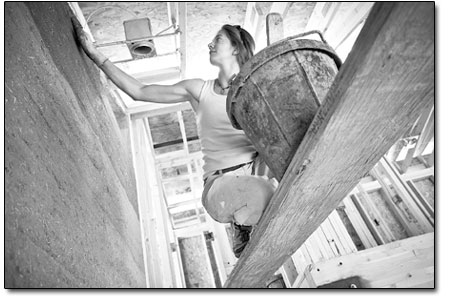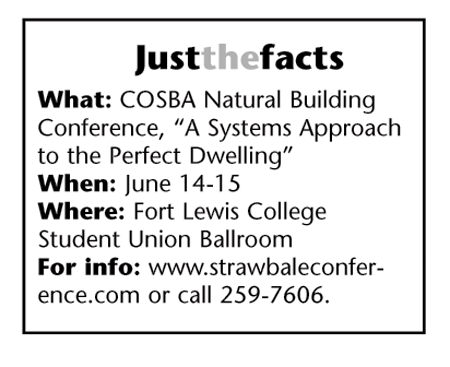| ||||
| Green heads for the mainstream Conference focuses on meeting of methods SideStory: ‘A Systems Approach to the Perfect Dwelling:’ Conference comes to FLC June 14-15
by John T. Rehorn The moment that every conscious builder has been awaiting has finally arrived. A natural homebuilder’s dogged insistence on ecologically ethical behavior is meeting the holiest of American holies: market forces. It’s a conjunction of sorts – like the alignment of two planets that portends the dawn of a new era. Well, not quite, perhaps. First there were the pains of childbirth – the five-dollar-a-gallon gas, home heating and cooling costs, mortgage crisis and the weak dollar. Then, one last push, a first breath and a wail, and at last: Sustainable home building goes conventional. The Colorado Straw Bale Association, a nonprofit group, is one of a team of midwives to that process, and to that end has announced its Seventh Annual Natural Building Conference, June 14-15 at the Fort Lewis College Union Ballroom. Keynote speakers will include Randy Udall, speaking on “America’s Energy Challenges,” and modern straw bale pioneer David Eisenberg, whose speech is entitled “Getting a Building Regulatory System that Meets Our Approval.” Titled “A Systems Approach to the Perfect Dwelling,” the annual conference is enjoying its second year in Durango, due in equal parts to the success of last year’s conference, a dedicated team of energetic volunteers, and the fact that the area has earned a reputation as a hotbed for natural building. Workshops will examine the various systems of home building from foundations to finishes, and explore how these systems interact with one another and how, through self-education, a person can take a few steps closer to the absolutely ideal home. Keynote speakers were selected to emphasize how a conscientiously built home fits into the global picture. Jennifer Wrenn, a business consultant and grant writer, is a key member of the conference organizing committee. She and husband, Andy Kayner, are in the midst of building their adobe dream home designed by local architect Greg Madeen. It is double-walled and heated by both geothermal and passive solar design techniques. Kayner, also a conference organizer, serves as the general contractor for their project. Wrenn says that in addition to attracting the dedicated natural builders of the region to the conference, this year’s approach is an even more inclusive effort. “We are really trying to reach out to the more conventional ‘stick frame’ builders,” Wrenn says. ”We want to try to present a whole continuum of options from totally conventional — to totally green and natural. The idea is that if a builder or an architect incorporates even one of these options, at least it’s a step in a more sustainable direction.” But why would a straw bale association promote anything other than straw bale construction? It’s all part of the inclusive approach, Wrenn says. “We believe in the overall idea of sustainable building — that there are lots of earth-friendly ways to build a home. Also, when you lay out all the methods side by side, straw bale homes really shine. It’s pretty amazing that you can grow enough straw for thousands of homes in only one growing season, where it takes decades to grow enough wood. Not only that, but the straw, which is really a waste product of growing food, is being recycled into a home, instead of going into a landfill.” Alas, an entire home cannot be made of straw. There are other materials, including wood, that must go in to the building of a straw bale home. “Recycled” and “recovered” are great places to start, but conscious building cannot exist without the word “local.” So says contractor Todd Swanson, who has been building and learning in Durango since 1988. That point is about to be driven home with a sledge hammer, he says. “The whole industry is going to get stood on its head,” he proclaims. “If you think about it, we’re going to have to start thinking regionally. We’re going from centralized materials supply to regional supply. And we’re going to have to start being more aware of our local culture and climate. Gone are the days when people can put up any structure anywhere, and nature and climate be damned.” Underlining that point is Eric Husted, of Lorax Forest Care. His company selectively thins ponderosa trees for fire mitigation and forest health. The logs are skidded out of the forest by Husted’s stalwart draft horses so that roads for internal combustion machinery are kept to a minimum. He then mills the harvested logs and supplies lumber to local timber-framers and shop carpenters. “We’re in a unique position where second growth ponderosa pine needs some mechanical thinning in our forests to return them to an old-growth status. If we don’t do something, that timber will either be burned or killed by insect infestation,” Husted says. “At this point, ponderosa harvest is a win/win situation for the ecosystem and for the people in this area.” Another conscious-building veteran of Southwest Colorado is Steven Kawell, who will be speaking about home site evaluation and foundations at the upcoming conference. Kawell, a builder in the area for 30 years, imports his product across vast distances (in the tens of millions of miles), but before he falls prey to judgmental greenies, let us state that his product is solar energy. “My passion is passive solar,” Kawell says. “It brings to the forefront that if you orient your house to the sun and design properly to the seasons, it creates a better home – one that synchronizes to nature and the movement of the sun and the elements.” Site selection thus becomes the crucial starting phase of any homebuilding project, he says. If you’ve found a great deal for land in a deep canyon or a lot in a neighborhood just north of a three-story structure, perhaps you should keep looking. The sun is the reason we folks in Durango should enjoy our southern views out of big windows and step outside if we want a view of the La Platas. An often overlooked homebuilding resource is one that seems to be in short supply in our society, according to Swanson. “One thing our culture hasn’t embraced is allowing time not only to develop the plan, but also have the materials come to you.” Swanson says that time is one of the intangible resources that many of his clients didn’t stock up on. “As soon as they call, they’re ready to move in,” he says. Time is a resource that begets knowledge. The conscientious builder is always learning, always willing to explore new techniques and innovative materials. Yet the market is driven by the client, who is, after all, the financier. The Colorado Straw Bale Association is betting that the public is the ultimate driver of the so-called “green building” movement. They think the public needs not to be informed, but to inform itself of what “green” really is. Says Wrenn, “I think a lot of people are interested in building something, even if they’re not a builder. They either have their dream home in mind, or they want to build a shed or a chicken coop or a garden wall. And it’s doubly fun to think of building it sustainably by yourself with bales of straw, or to make bricks from the dirt in your backyard.” However, she says the driving force of change is not based on an afterthought but more on a forethought. “People are starting to understand that as a society, or even as a planet, we don’t have a choice about this any longer,” she says. “It’s become obvious that we just can’t keep doing things the same old, wasteful way. The planet probably will survive our excesses, but our children and grandchildren might not.” •
|



